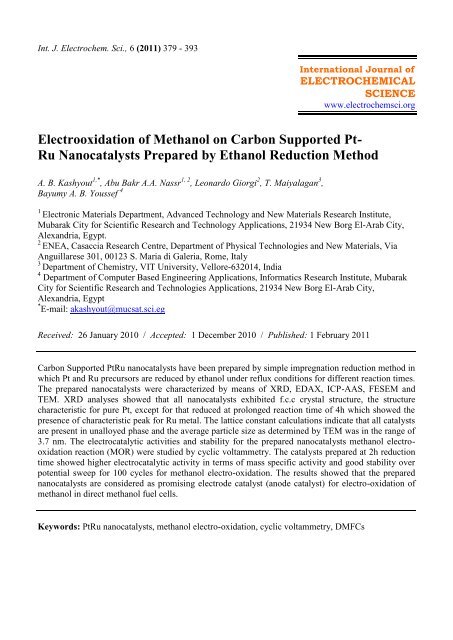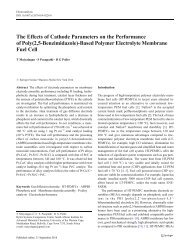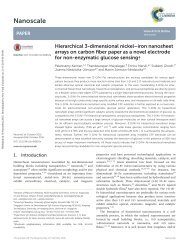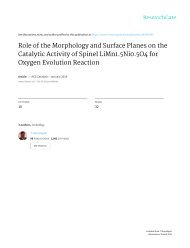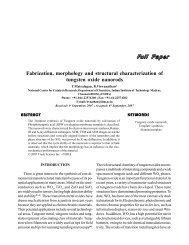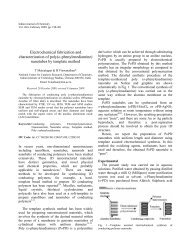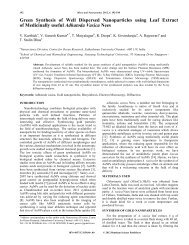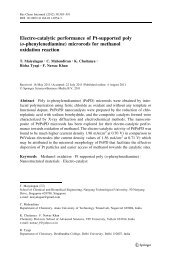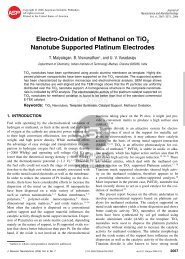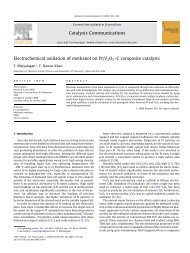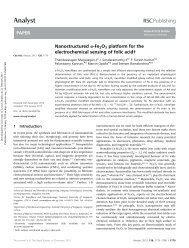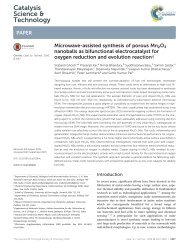Electrooxidation of Methanol on Carbon Supported Pt-Ru Nanocatalysts Prepared by Ethanol Reduction Method
Create successful ePaper yourself
Turn your PDF publications into a flip-book with our unique Google optimized e-Paper software.
Int. J. Electrochem. Sci., 6 (2011) 379 - 393<br />
Internati<strong>on</strong>al Journal <str<strong>on</strong>g>of</str<strong>on</strong>g><br />
ELECTROCHEMICAL<br />
SCIENCE<br />
www.electrochemsci.org<br />
<str<strong>on</strong>g>Electrooxidati<strong>on</strong></str<strong>on</strong>g> <str<strong>on</strong>g>of</str<strong>on</strong>g> <str<strong>on</strong>g>Methanol</str<strong>on</strong>g> <strong>on</strong> Carb<strong>on</strong> <strong>Supported</strong> <strong>Pt</strong>-<br />
<strong>Ru</strong> <strong>Nanocatalysts</strong> <strong>Prepared</strong> <strong>by</strong> <strong>Ethanol</strong> Reducti<strong>on</strong> <strong>Method</strong><br />
A. B. Kashyout 1,* , Abu Bakr A.A. Nassr 1, 2 , Le<strong>on</strong>ardo Giorgi 2 , T. Maiyalagan 3 ,<br />
Bayumy A. B. Youssef 4<br />
1<br />
Electr<strong>on</strong>ic Materials Department, Advanced Technology and New Materials Research Institute,<br />
Mubarak City for Scientific Research and Technology Applicati<strong>on</strong>s, 21934 New Borg El-Arab City,<br />
Alexandria, Egypt.<br />
2<br />
ENEA, Casaccia Research Centre, Department <str<strong>on</strong>g>of</str<strong>on</strong>g> Physical Technologies and New Materials, Via<br />
Anguillarese 301, 00123 S. Maria di Galeria, Rome, Italy<br />
3<br />
Department <str<strong>on</strong>g>of</str<strong>on</strong>g> Chemistry, VIT University, Vellore-632014, India<br />
4 Department <str<strong>on</strong>g>of</str<strong>on</strong>g> Computer Based Engineering Applicati<strong>on</strong>s, Informatics Research Institute, Mubarak<br />
City for Scientific Research and Technologies Applicati<strong>on</strong>s, 21934 New Borg El-Arab City,<br />
Alexandria, Egypt<br />
* E-mail: akashyout@mucsat.sci.eg<br />
Received: 26 January 2010 / Accepted: 1 December 2010 / Published: 1 February 2011<br />
Carb<strong>on</strong> <strong>Supported</strong> <strong>Pt</strong><strong>Ru</strong> nanocatalysts have been prepared <strong>by</strong> simple impregnati<strong>on</strong> reducti<strong>on</strong> method in<br />
which <strong>Pt</strong> and <strong>Ru</strong> precursors are reduced <strong>by</strong> ethanol under reflux c<strong>on</strong>diti<strong>on</strong>s for different reacti<strong>on</strong> times.<br />
The prepared nanocatalysts were characterized <strong>by</strong> means <str<strong>on</strong>g>of</str<strong>on</strong>g> XRD, EDAX, ICP-AAS, FESEM and<br />
TEM. XRD analyses showed that all nanocatalysts exhibited f.c.c crystal structure, the structure<br />
characteristic for pure <strong>Pt</strong>, except for that reduced at prol<strong>on</strong>ged reacti<strong>on</strong> time <str<strong>on</strong>g>of</str<strong>on</strong>g> 4h which showed the<br />
presence <str<strong>on</strong>g>of</str<strong>on</strong>g> characteristic peak for <strong>Ru</strong> metal. The lattice c<strong>on</strong>stant calculati<strong>on</strong>s indicate that all catalysts<br />
are present in unalloyed phase and the average particle size as determined <strong>by</strong> TEM was in the range <str<strong>on</strong>g>of</str<strong>on</strong>g><br />
3.7 nm. The electrocatalytic activities and stability for the prepared nanocatalysts methanol electrooxidati<strong>on</strong><br />
reacti<strong>on</strong> (MOR) were studied <strong>by</strong> cyclic voltammetry. The catalysts prepared at 2h reducti<strong>on</strong><br />
time showed higher electrocatalytic activity in terms <str<strong>on</strong>g>of</str<strong>on</strong>g> mass specific activity and good stability over<br />
potential sweep for 100 cycles for methanol electro-oxidati<strong>on</strong>. The results showed that the prepared<br />
nanocatalysts are c<strong>on</strong>sidered as promising electrode catalyst (anode catalyst) for electro-oxidati<strong>on</strong> <str<strong>on</strong>g>of</str<strong>on</strong>g><br />
methanol in direct methanol fuel cells.<br />
Keywords: <strong>Pt</strong><strong>Ru</strong> nanocatalysts, methanol electro-oxidati<strong>on</strong>, cyclic voltammetry, DMFCs
Int. J. Electrochem. Sci., Vol. 6, 2011 380<br />
1. INTRODUCTION<br />
The electro-oxidati<strong>on</strong> <str<strong>on</strong>g>of</str<strong>on</strong>g> small organic molecules <strong>on</strong> <strong>Pt</strong> electrocatalysts based electrodes has<br />
received more attenti<strong>on</strong> in the last decades due their applicati<strong>on</strong> for electrochemical energy c<strong>on</strong>versi<strong>on</strong><br />
in direct liquid feed fuel cells [1-3]. Am<strong>on</strong>g these molecules; methanol is used as liquid fuel for direct<br />
methanol fuel cells (DMFCs). It has a higher electr<strong>on</strong> density (six electr<strong>on</strong> producti<strong>on</strong> during its<br />
electro-oxidati<strong>on</strong>) and it has a good electrochemical activity due to the presence <str<strong>on</strong>g>of</str<strong>on</strong>g> electroactive<br />
hydroxyl group which can be attached or adsorbed to the electrode surface [4].<br />
The electro-oxidati<strong>on</strong> <str<strong>on</strong>g>of</str<strong>on</strong>g> methanol has been studied <strong>on</strong> many electrode fabricated from<br />
unsupported metals and metal supported <strong>on</strong>to different supporting materials. <strong>Pt</strong> catalysts are still the<br />
most active catalysts materials for electro-oxidati<strong>on</strong> <str<strong>on</strong>g>of</str<strong>on</strong>g> methanol [3, 5-9]. The electro-oxidati<strong>on</strong> <str<strong>on</strong>g>of</str<strong>on</strong>g><br />
methanol <strong>on</strong> <strong>Pt</strong> electrode surface is combined with several steps <str<strong>on</strong>g>of</str<strong>on</strong>g> dehydrogenati<strong>on</strong> to form CO which<br />
is oxidized into CO 2 [10, 11]. The pois<strong>on</strong>ing <str<strong>on</strong>g>of</str<strong>on</strong>g> the electrode surface (anode) <strong>by</strong> CO molecules formed<br />
during the methanol oxidati<strong>on</strong> is <strong>on</strong>e <str<strong>on</strong>g>of</str<strong>on</strong>g> the obstacles in the development <str<strong>on</strong>g>of</str<strong>on</strong>g> DMFCs for commercial<br />
applicati<strong>on</strong>s. The modificati<strong>on</strong> <str<strong>on</strong>g>of</str<strong>on</strong>g> <strong>Pt</strong> catalysts with other metals or metal oxides which have higher<br />
tendency to form surface oxygenated species at lower potential is c<strong>on</strong>sidered as <strong>on</strong>e <str<strong>on</strong>g>of</str<strong>on</strong>g> the best ways to<br />
solve this problem [12, 13]. In this regard, many efforts have been d<strong>on</strong>e <strong>by</strong> many groups to synthesis<br />
new catalysts systems for methanol oxidati<strong>on</strong> based <strong>on</strong> bimetallic catalysts such as <strong>Pt</strong><strong>Ru</strong>[14-17],<br />
<strong>Pt</strong>Sn[18,19], <strong>Pt</strong>Ni[20,21], <strong>Pt</strong>Mo[22,23],ternary alloy ; <strong>Pt</strong><strong>Ru</strong>Ni[24-26], <strong>Pt</strong><strong>Ru</strong>Mo[25,27,28], and <strong>Pt</strong>MO x<br />
(where M is, Ti, V, Mn, W) [29-32].<br />
Am<strong>on</strong>g all catalyst systems, <strong>Pt</strong><strong>Ru</strong> catalysts prepared as nanoparticles have received more<br />
attenti<strong>on</strong> due to its high CO tolerance. The formati<strong>on</strong> <str<strong>on</strong>g>of</str<strong>on</strong>g> surface oxygenated species <strong>on</strong> <strong>Ru</strong> takes place<br />
at a potential lower than that <strong>on</strong> <strong>Pt</strong>. So, the presence <str<strong>on</strong>g>of</str<strong>on</strong>g> <strong>Ru</strong> adjacent to <strong>Pt</strong> reduces the pois<strong>on</strong>ing <str<strong>on</strong>g>of</str<strong>on</strong>g> <strong>Pt</strong><br />
surface <strong>by</strong> CO [8,9]. In this catalyst system, <strong>Pt</strong> services as active sites for methanol adsorpti<strong>on</strong> and<br />
dehydrogenati<strong>on</strong> while <strong>Ru</strong> serves as catalyst promoter <strong>on</strong> which CO is oxidized into CO 2 . This model<br />
mechanism is known as bifuncti<strong>on</strong>al mechanism. Other model is suggested based <strong>on</strong> electr<strong>on</strong>ic<br />
structure change up<strong>on</strong> additi<strong>on</strong> <str<strong>on</strong>g>of</str<strong>on</strong>g> <strong>Ru</strong>. According to this model, the additi<strong>on</strong> <str<strong>on</strong>g>of</str<strong>on</strong>g> <strong>Ru</strong> can change the<br />
electr<strong>on</strong>ic structure <str<strong>on</strong>g>of</str<strong>on</strong>g> catalyst surface which lead to decrease the b<strong>on</strong>ding between the CO molecules<br />
and <strong>Pt</strong> catalyst surface [8, 9, 33].<br />
Many research groups are working to explore preparati<strong>on</strong> method for <strong>Pt</strong><strong>Ru</strong> catalyst system [7].<br />
The catalytic activity <str<strong>on</strong>g>of</str<strong>on</strong>g> the catalysts depends <strong>on</strong> their preparati<strong>on</strong> methods. Also, the cost <str<strong>on</strong>g>of</str<strong>on</strong>g> catalysts<br />
preparati<strong>on</strong> process should be taken into c<strong>on</strong>siderati<strong>on</strong> for the applicati<strong>on</strong> in fuel cells. Therefore; the<br />
searching for simple preparati<strong>on</strong> methods with low cost and high catalytic activity will lead to the<br />
development <str<strong>on</strong>g>of</str<strong>on</strong>g> fuel cells industry.<br />
Wet chemical method or some times called chemical impregnati<strong>on</strong> method is c<strong>on</strong>sidered as the<br />
most powerful method for preparati<strong>on</strong> <str<strong>on</strong>g>of</str<strong>on</strong>g> catalysts nanoparticles specially; supported <strong>Pt</strong><strong>Ru</strong> catalysts.<br />
The procedures for this method are easy and can be developed for large-scale producti<strong>on</strong> [7, 34]. In<br />
wet chemical method, the metal precursors are impregnated <strong>on</strong> the carb<strong>on</strong> support in aqueous or/and<br />
organic media followed <strong>by</strong> the reducti<strong>on</strong> using reducing agent such as sodium borohydride, formic<br />
acid, hydrazine. Also, the organic alcohols (methanol, ethanol, isopropanol and ethylene glycol,<br />
glycerol and diethylene glycol) are known as good reducing agents for the preparati<strong>on</strong> <str<strong>on</strong>g>of</str<strong>on</strong>g> <strong>Pt</strong><strong>Ru</strong> and
Int. J. Electrochem. Sci., Vol. 6, 2011 381<br />
other nanoparticles. Advantages <str<strong>on</strong>g>of</str<strong>on</strong>g> using alcohols as reducing agent are that there is no side reacti<strong>on</strong><br />
products can be obtained and the formati<strong>on</strong> <str<strong>on</strong>g>of</str<strong>on</strong>g> relative pure nanoparticles are well synthesized<br />
[7,34,35].<br />
The reducti<strong>on</strong> process are carried out in presence <str<strong>on</strong>g>of</str<strong>on</strong>g> stabilizers such as PVA or other polymers<br />
or surfactant materials which serve as capping agent to prevent the particle agglomerati<strong>on</strong>. In fact,<br />
these capping materials have adverse effect <strong>on</strong> the electrocatalytic activity, since these stabilizers are<br />
adsorbed <strong>on</strong> the surface <str<strong>on</strong>g>of</str<strong>on</strong>g> the nanoparticles catalysts and blocking the active sites available for the<br />
electrochemical reacti<strong>on</strong> in additi<strong>on</strong> to its lower electrical c<strong>on</strong>ductivity. Also, the removal <str<strong>on</strong>g>of</str<strong>on</strong>g> these<br />
protective agents <strong>by</strong> heat treatment may be has side-effect <strong>on</strong> the electrocatalytic activity due the<br />
change <str<strong>on</strong>g>of</str<strong>on</strong>g> crystal structure <str<strong>on</strong>g>of</str<strong>on</strong>g> the active phase in the catalysts or increase their particle size [36, 37].<br />
Lee e.t al. prepared <strong>Pt</strong><strong>Ru</strong>/C nanocataysts using ethanol reducti<strong>on</strong> method and tested the<br />
prepared catalysts for methanol electooxidati<strong>on</strong> reacti<strong>on</strong> [38]. The results showed that the preparati<strong>on</strong><br />
process has adverse effect <strong>on</strong> the electrocatalytic activity when carried out in alkaline media. Also,<br />
carb<strong>on</strong> supported <strong>Pt</strong> and <strong>Pt</strong>Au catalysts as electrocatalysts for oxygen reducti<strong>on</strong> reacti<strong>on</strong> (ORR) have<br />
been prepared <strong>by</strong> ethanol reducti<strong>on</strong> method in the presence <str<strong>on</strong>g>of</str<strong>on</strong>g> PVP as stabilizing and complexing<br />
agent. The reducti<strong>on</strong> process were carried out in alkaline media. The removal <str<strong>on</strong>g>of</str<strong>on</strong>g> the stabilizing agent<br />
was carried out <strong>by</strong> heating the catalysts at high temperature in air followed <strong>by</strong> their reducti<strong>on</strong> in flow<br />
<str<strong>on</strong>g>of</str<strong>on</strong>g> hydrogen at elevated temperature. The prepared electrocatalysts showed good electrocatalytic<br />
activity towards ORR [39].<br />
In this work, we report a simple method for preparati<strong>on</strong> <str<strong>on</strong>g>of</str<strong>on</strong>g> <strong>Pt</strong><strong>Ru</strong> nanoparticles supported <strong>on</strong><br />
carb<strong>on</strong> support (Vulcan XC-72R) <strong>by</strong> using ethanol as a reducing agent without using any stabilizers<br />
and no modificati<strong>on</strong> <str<strong>on</strong>g>of</str<strong>on</strong>g> the preparati<strong>on</strong> media (pH) and without heat treatment. The prepared<br />
nanocatalysts are characterized <strong>by</strong> means <str<strong>on</strong>g>of</str<strong>on</strong>g> structural tools; XRD, FESEM and TEM and chemical<br />
analyses <strong>by</strong> EDAX and ICP-AAS. The electrocatalytic activity is tested for methanol electrooxidati<strong>on</strong><br />
<strong>by</strong> cyclic voltammetry technique. The effect <str<strong>on</strong>g>of</str<strong>on</strong>g> reducti<strong>on</strong> time <strong>on</strong> the durability <str<strong>on</strong>g>of</str<strong>on</strong>g> the catalysts is also<br />
studied.<br />
2. EXPERIMENTAL PART<br />
2.1. Electrocatalyst Preparati<strong>on</strong><br />
In this work, a carb<strong>on</strong> supported <strong>Pt</strong><strong>Ru</strong> nanoparticles electrocatalyst with atomic ratio <strong>Pt</strong>:<strong>Ru</strong><br />
(1:1) and 20% wt <str<strong>on</strong>g>of</str<strong>on</strong>g> metal loading (<strong>Pt</strong><strong>Ru</strong>) <strong>on</strong> carb<strong>on</strong> was prepared according to the following<br />
procedures. 100 mg <str<strong>on</strong>g>of</str<strong>on</strong>g> carb<strong>on</strong> (Vulcan XC-72R) was dispersed in 20 ml ethanol in an ultras<strong>on</strong>ic bath<br />
for 15 min. To the above suspensi<strong>on</strong>; 34.6 mg <str<strong>on</strong>g>of</str<strong>on</strong>g> H 2 <strong>Pt</strong>Cl 6 dissolved in 5 ml water and 17.5 mg <str<strong>on</strong>g>of</str<strong>on</strong>g><br />
<strong>Ru</strong>Cl 3 dissolved in 5 ml <str<strong>on</strong>g>of</str<strong>on</strong>g> water were added and then 80 ml <str<strong>on</strong>g>of</str<strong>on</strong>g> ethanol was also added to the reacti<strong>on</strong><br />
mixture. The total mixture was kept under stirring for 1h followed <strong>by</strong> s<strong>on</strong>icati<strong>on</strong> in an ultras<strong>on</strong>ic bath<br />
for 30 min to insure the adsorpti<strong>on</strong> and dispersi<strong>on</strong> <str<strong>on</strong>g>of</str<strong>on</strong>g> the metal precursors <strong>on</strong> the carb<strong>on</strong> support. The<br />
resulted mixture was heated under reflux at (80 ± 2°C) under stirring for different reacti<strong>on</strong> times after<br />
which the reacti<strong>on</strong> mixture was leaved to cool to room temperature and then centrifuged to separate the
Int. J. Electrochem. Sci., Vol. 6, 2011 382<br />
catalysts powder. The catalysts were subjected to many cycles <str<strong>on</strong>g>of</str<strong>on</strong>g> washing with water and centrifuge<br />
until no Cl – i<strong>on</strong>s were detected (silver nitrite test) and then dried in vacuum oven at 100°C for 12h.<br />
The reductive reacti<strong>on</strong>s can be represented <strong>by</strong> the following equati<strong>on</strong>s [38]:<br />
H 2 <strong>Pt</strong>Cl 6 + 2C 2 H 5 OH → <strong>Pt</strong> + 2 CH 3 CHO + 6 HCl<br />
2<strong>Ru</strong>Cl 3 + 3C 2 H 5 OH<br />
→ 2<strong>Ru</strong> + 2 CH 3 CHO + 6 HCl<br />
The <strong>Pt</strong><strong>Ru</strong>/C catalysts produced during this work are (<strong>Pt</strong><strong>Ru</strong>/C1, <strong>Pt</strong><strong>Ru</strong>/C2 and <strong>Pt</strong><strong>Ru</strong>/C4). These<br />
labels are giving according to their reacti<strong>on</strong> times <str<strong>on</strong>g>of</str<strong>on</strong>g> 1h, 2h and 4h; respectively.<br />
2.2. Electrocatalyst Characterizati<strong>on</strong><br />
2.2.1. Physical and Chemical Characterizati<strong>on</strong><br />
The total metal loading was determined <strong>by</strong> ICP-AAS (Prodigy, high dispersi<strong>on</strong> ICP, Leman).<br />
The measurement was carried out <strong>by</strong> collecting all the filtrates during the washing process and<br />
determining the c<strong>on</strong>centrati<strong>on</strong> <str<strong>on</strong>g>of</str<strong>on</strong>g> <strong>Pt</strong> and <strong>Ru</strong> c<strong>on</strong>tents in the filtrate from which we can calculate the<br />
amount <str<strong>on</strong>g>of</str<strong>on</strong>g> metal loading <strong>on</strong> the carb<strong>on</strong> support. The chemical compositi<strong>on</strong> <str<strong>on</strong>g>of</str<strong>on</strong>g> the prepared catalysts<br />
was determined <strong>by</strong> the energy dispersive X-ray analysis (EDAX) combined with SEM (JEOL JSM<br />
6360LA). X-ray diffracti<strong>on</strong> study <str<strong>on</strong>g>of</str<strong>on</strong>g> the prepared nanocatalysts were carried out using (Schimadzu<br />
7000) diffractometer, operating with Cu Kα radiati<strong>on</strong> (λ=0.154060 nm) generated at 30 kV and 30 mA<br />
with scanning rate <str<strong>on</strong>g>of</str<strong>on</strong>g> 2º min -1 for 2θ values between 20 and 90º degree. The nanocatalysts morphology<br />
and dispersi<strong>on</strong> <strong>on</strong> the support and their particle size were investigated <strong>by</strong> FESEM (LEO 1530) and<br />
TEM (JEOL, 200CX). The samples were prepared <strong>by</strong> dispersi<strong>on</strong> <str<strong>on</strong>g>of</str<strong>on</strong>g> the catalysts powder in ethanol and<br />
s<strong>on</strong>icati<strong>on</strong>, then the sample was deposited <strong>on</strong> a diam<strong>on</strong>d polished graphite paper supported <strong>on</strong><br />
aluminum sample holder for FESEM analysis and <strong>on</strong> carb<strong>on</strong> coated Cu grid for TEM analysis.<br />
The average particle size and particle size distributi<strong>on</strong> are acquired using FORTRAN code. The<br />
code has been made to apply the image processing rules <strong>on</strong> the TEM images <str<strong>on</strong>g>of</str<strong>on</strong>g> <strong>Pt</strong><strong>Ru</strong>/C catalysts to<br />
determine exactly the average particle size and the particles size distributi<strong>on</strong> from digital images.<br />
The code design steps are removing the background (the carb<strong>on</strong> support), clustering the pixels<br />
which form each particle and finally computing the diameter <str<strong>on</strong>g>of</str<strong>on</strong>g> each particle [40]. Removing <str<strong>on</strong>g>of</str<strong>on</strong>g><br />
background has been d<strong>on</strong>e using the threshold technique. For clustering <str<strong>on</strong>g>of</str<strong>on</strong>g> the pixels; the clustering<br />
based iterative method has been used. The method mainly depends <strong>on</strong> getting certain relati<strong>on</strong> between<br />
each pixel and its neighbors. This relati<strong>on</strong> is applied iteratively until the results <str<strong>on</strong>g>of</str<strong>on</strong>g> this relati<strong>on</strong> have no<br />
variati<strong>on</strong> with increasing the iterati<strong>on</strong>:<br />
1. Starting with two arrays (A, B) which have a number <str<strong>on</strong>g>of</str<strong>on</strong>g> elements. Each element is<br />
corresp<strong>on</strong>ding to each pixel <str<strong>on</strong>g>of</str<strong>on</strong>g> image.
Int. J. Electrochem. Sci., Vol. 6, 2011 383<br />
2. Fill the arrays A and B with large number. This number must be greater than the expected<br />
particles number (LN)<br />
3. Putting a variable N as counter for particle Number<br />
4. Starting N=0<br />
5. Calculating every array elements according the next relati<strong>on</strong>:<br />
B<br />
Min( Ai<br />
1,<br />
j<br />
, Ai<br />
1,<br />
j<br />
, Ai<br />
, j1,<br />
Ai<br />
, j 1)<br />
i, j<br />
<br />
6. If A<br />
i , j<br />
is equal to the larger number LN then N N 1<br />
and A i , j<br />
N<br />
7. If A<br />
i , j<br />
is less than (LN) , A<br />
i , j<br />
remains unchanged<br />
8. Getting r A B<br />
9. If r equal zero the soluti<strong>on</strong> is accomplished if not the program must execute steps 5,6,7,8,9<br />
after putting<br />
A B<br />
Finally, the array A c<strong>on</strong>tains the particle numbers corresp<strong>on</strong>ding to all pixels <str<strong>on</strong>g>of</str<strong>on</strong>g> the image.<br />
From the total number <str<strong>on</strong>g>of</str<strong>on</strong>g> pixel we calculated the area <str<strong>on</strong>g>of</str<strong>on</strong>g> each particle which subsequently used to<br />
calculate the particle size.<br />
2.2.2. Electrochemical Measurements<br />
The electrocatalytic activities <str<strong>on</strong>g>of</str<strong>on</strong>g> the prepared catalysts were evaluated towards methanol<br />
electrooxidati<strong>on</strong> reacti<strong>on</strong> (MOR) in a standard three electrodes electrochemical cell in which statured<br />
calomel electrode (SCE) (0.241 vs. NHE) and high purity graphite electrode were used as reference<br />
electrode and counter electrode; respectively. The working electrode is glass carb<strong>on</strong> disc (GCD)<br />
electrode coated with the catalyst layer. The catalysts layer was prepared <strong>by</strong> mixing the catalyst<br />
powder with Nafi<strong>on</strong> soluti<strong>on</strong> (10% Wt , DuP<strong>on</strong>t), water and isopropanol and then s<strong>on</strong>icated in<br />
ultras<strong>on</strong>ic water bath for 15 min followed <strong>by</strong> magnetic stirring for1h to form a catalyst ink which<br />
finally coated <strong>on</strong> GCD and dried for 20 min at 80 ºC. The working electrode area was 0.79 cm 2 and the<br />
amount <str<strong>on</strong>g>of</str<strong>on</strong>g> catalysts loading (<strong>Pt</strong><strong>Ru</strong> in mg/cm 2 ) in the working electrode was c<strong>on</strong>trolled to be 0.2<br />
mg/cm 2 . The measurements were carried out with EG&G 273A potentiostat/galvanostat from<br />
Princet<strong>on</strong> Applied Research (PAR) and c<strong>on</strong>trolled with Corware/Corview s<str<strong>on</strong>g>of</str<strong>on</strong>g>tware (Scribner<br />
Associates). The electrode measurements were activated in 1M H 2 SO 4 <strong>by</strong> sweep the electrode between<br />
-0.28 – 1 V (SCE) with a scan rate <str<strong>on</strong>g>of</str<strong>on</strong>g> 100 mVs -1 till the reproducible voltammogram was obtained<br />
(about 100 cycles). The electrocatalytic activity for methanol electro-oxidati<strong>on</strong> was tested in 0.5 M<br />
CH 3 OH/1 M H 2 SO 4 soluti<strong>on</strong> in the same potential window and at the same scan rate. Before the<br />
electrochemical measurements, the cell was bubbled with N 2 gas for at least 20 min and the N 2 gas<br />
flow was maintained over the soluti<strong>on</strong> surface during the measurements. All chemicals during this
Int. J. Electrochem. Sci., Vol. 6, 2011 384<br />
work were an analytical reagent grade and the soluti<strong>on</strong>s were prepared from distilled water. The<br />
measurements were carried out at room temperature.<br />
3. RESULTS AND DISCUSSION<br />
3.1. Physical and chemical characterizati<strong>on</strong><br />
3.1.1. Chemical compositi<strong>on</strong> analysis<br />
Metal atomic compositi<strong>on</strong> (<strong>Pt</strong>:<strong>Ru</strong>, atomic ratio) and weight percent determined <strong>by</strong> EDAX and<br />
the ICP are shown in Table (1). <strong>Pt</strong>:<strong>Ru</strong> is very closed to 1:1 atomic ratio which agrees with the nominal<br />
c<strong>on</strong>centrati<strong>on</strong> <str<strong>on</strong>g>of</str<strong>on</strong>g> <strong>Pt</strong> and <strong>Ru</strong> in the starting precursor. During the EDAX analysis, no peaks for Cl or Na<br />
were observed, which insure that these undesirable elements were removed during the washing<br />
process. On the other hand, ICP analyses showed that the <strong>Pt</strong><strong>Ru</strong> loading was 18 wt% for all catalysts<br />
which is near to the starting loading percentage <str<strong>on</strong>g>of</str<strong>on</strong>g> 20 % and c<strong>on</strong>firms that almost all the <strong>Pt</strong> and <strong>Ru</strong> i<strong>on</strong>s<br />
are reduced to their corresp<strong>on</strong>ding metallic state.<br />
Table 1. Chemical compositi<strong>on</strong> <str<strong>on</strong>g>of</str<strong>on</strong>g> <strong>Pt</strong><strong>Ru</strong>/C catalysts from EDAX and ICP-ASS Analyses<br />
Catalysts Type Reacti<strong>on</strong> time At % (from EDAX) Wt % (From ICP-Ass)<br />
hr <strong>Pt</strong> <strong>Ru</strong> <strong>Pt</strong> <strong>Ru</strong><br />
<strong>Pt</strong><strong>Ru</strong>/C1 1 47.59 52.41 11 7<br />
<strong>Pt</strong><strong>Ru</strong>/C2 2 48.05 51.95 11 7<br />
<strong>Pt</strong><strong>Ru</strong>/C4 4 45.11 54.89 11 7<br />
3.1.2. X-ray diffracti<strong>on</strong><br />
Fig.(1) shows the X-ray diffracti<strong>on</strong> patterns for the prepared catalysts, e.g. <strong>Pt</strong><strong>Ru</strong>/C1, <strong>Pt</strong><strong>Ru</strong>C2<br />
and <strong>Pt</strong><strong>Ru</strong>C3 respectively. X-ray diffracti<strong>on</strong> analyses show that all catalysts exhibit the diffracti<strong>on</strong><br />
peaks <str<strong>on</strong>g>of</str<strong>on</strong>g> (111), (200), (220) and (311), respectively.<br />
Table (2): Diffracti<strong>on</strong> peaks for <strong>Pt</strong><strong>Ru</strong>/C catalysts and pure <strong>Pt</strong> with their corresp<strong>on</strong>ding 2θ value<br />
Catalysts Type (111) (200) (220) (311)<br />
Pure <strong>Pt</strong> 39.7º 46.2º 67.4º 81.2º<br />
<strong>Pt</strong><strong>Ru</strong>/C1 39.8º 46.2º 67.8º 81.6º<br />
<strong>Pt</strong><strong>Ru</strong>/C2 39.8º 46.2º 67.7º 81.6º<br />
<strong>Pt</strong><strong>Ru</strong>/C4 39.9º 46.1º 67.8º 81.6º<br />
These peaks are the characteristic for <strong>Pt</strong> face-centered cubic structure (f.c.c) (JCPDS Card No.<br />
04-802). The wide peak near 2θ = 25° corresp<strong>on</strong>ds to the diffracti<strong>on</strong> <str<strong>on</strong>g>of</str<strong>on</strong>g> the carb<strong>on</strong> support (Vulcan
Intensity (a.u)<br />
Int. J. Electrochem. Sci., Vol. 6, 2011 385<br />
XC-72R). The diffracti<strong>on</strong> peaks are located approximately at nearly 2θ values as that <str<strong>on</strong>g>of</str<strong>on</strong>g> pure metallic<br />
<strong>Pt</strong> as shown in Table 2. Since there is no shift <str<strong>on</strong>g>of</str<strong>on</strong>g> the diffracti<strong>on</strong> peaks for higher 2θ value than that <str<strong>on</strong>g>of</str<strong>on</strong>g><br />
pure <strong>Pt</strong>, no alloys formati<strong>on</strong> or solid soluti<strong>on</strong> between <strong>Pt</strong> and <strong>Ru</strong> in the prepared <strong>Pt</strong><strong>Ru</strong>/C can be<br />
detected which is in agree with the results <str<strong>on</strong>g>of</str<strong>on</strong>g> lattice c<strong>on</strong>stant calculated for all the prepared catalysts<br />
(Table. 3) [41].<br />
350<br />
(111)<br />
(200)<br />
(220)<br />
(<strong>Pt</strong><strong>Ru</strong>/C4)<br />
(311)<br />
(<strong>Pt</strong><strong>Ru</strong>/C2)<br />
(<strong>Pt</strong><strong>Ru</strong>/C1)<br />
20 30 40 50 60 70 80 90<br />
2 (Degree)<br />
Figure 1. XRD patterns for <strong>Pt</strong><strong>Ru</strong>/C catalysts prepared at different reacti<strong>on</strong> time.<br />
For the catalysts <strong>Pt</strong><strong>Ru</strong>/C1 and <strong>Pt</strong><strong>Ru</strong>/C2, there are no diffracti<strong>on</strong> peaks characteristic for<br />
<strong>Ru</strong> or its oxide, even with the smooth pr<str<strong>on</strong>g>of</str<strong>on</strong>g>ile obtained after eliminati<strong>on</strong> <str<strong>on</strong>g>of</str<strong>on</strong>g> the back ground and high<br />
frequency noise <strong>by</strong> the instrumental s<str<strong>on</strong>g>of</str<strong>on</strong>g>tware. The same results are reported <strong>by</strong> many groups for<br />
<strong>Pt</strong><strong>Ru</strong>/C catalysts [41-43] and this may be attributed to <strong>Pt</strong> that is decorated <strong>by</strong> <strong>Ru</strong> particles or may be<br />
<strong>Ru</strong> is present in amorphous phase or in form <str<strong>on</strong>g>of</str<strong>on</strong>g> hydrous <strong>Ru</strong>-oxide [43-46]. For <strong>Pt</strong><strong>Ru</strong>/C4 catalyst, there<br />
is a new low intensity diffracti<strong>on</strong> peak at about 2θ =44° between those <str<strong>on</strong>g>of</str<strong>on</strong>g> <strong>Pt</strong> (111) and (200). The peak<br />
was detected from the smooth pr<str<strong>on</strong>g>of</str<strong>on</strong>g>ile <str<strong>on</strong>g>of</str<strong>on</strong>g> XRD pattern for <strong>Pt</strong><strong>Ru</strong>/C4. This peak is the characteristic for<br />
(101) diffracti<strong>on</strong> plane <str<strong>on</strong>g>of</str<strong>on</strong>g> <strong>Ru</strong>, most intense reflecti<strong>on</strong> plane for h.c.p <strong>Ru</strong> [46]. This suggests that in<br />
<strong>Pt</strong><strong>Ru</strong>/C4, <strong>Ru</strong> is presence as a separate phase.<br />
The particle size for all the prepared catalysts is calculated from the width <str<strong>on</strong>g>of</str<strong>on</strong>g> (220) diffracti<strong>on</strong><br />
peak using Gaussian fitting using Scherer equati<strong>on</strong> [42,43,47]:<br />
0.95<br />
<br />
D <br />
2 <br />
cos<br />
max<br />
Where D is the particle size in (nm), λ is the wave length (0.15406 nm), β 2θ is the fullwidth at<br />
half maxima in radius and θ max is the angle at high maxima.
Int. J. Electrochem. Sci., Vol. 6, 2011 386<br />
The lattice c<strong>on</strong>stant for the prepared catalysts was calculated from (220) diffracti<strong>on</strong> peak <strong>by</strong><br />
using Bragg law according to the following equati<strong>on</strong> [42, 43]:<br />
a<br />
fcc<br />
2<br />
<br />
sin<br />
The particle size and the lattice c<strong>on</strong>stant for all prepared catalysts are given in Table (3). For all<br />
the prepared catalysts, the calculated particle size is nearly equal to about 3.7 and 3.8 nm which<br />
indicates that the particle size is slightly influenced <strong>by</strong> the reacti<strong>on</strong> time.<br />
Also, the lattice c<strong>on</strong>stants for all the catalysts are much closed to that <str<strong>on</strong>g>of</str<strong>on</strong>g> pure <strong>Pt</strong> which c<strong>on</strong>firms<br />
that <strong>Pt</strong><strong>Ru</strong> catalysts are present in unalloyed form.<br />
The relative crystallinity <str<strong>on</strong>g>of</str<strong>on</strong>g> the prepared catalysts can be calculated from the ratio between the<br />
height peak <str<strong>on</strong>g>of</str<strong>on</strong>g> <strong>Pt</strong> (111) and peak reflecti<strong>on</strong> <str<strong>on</strong>g>of</str<strong>on</strong>g> the carb<strong>on</strong>. These values <str<strong>on</strong>g>of</str<strong>on</strong>g> relative crystallinity are<br />
given in Table (3). From Table (3), catalysts <strong>Pt</strong><strong>Ru</strong>/C2 has a higher crystallinity than that <str<strong>on</strong>g>of</str<strong>on</strong>g> <strong>Pt</strong><strong>Ru</strong>/C1<br />
and <strong>Pt</strong><strong>Ru</strong>/C4.<br />
Table 3. The structural parameters for <strong>Pt</strong><strong>Ru</strong>/C catalysts from XRD analysis and average particle size<br />
from TEM calculati<strong>on</strong>s.<br />
Catalysts type Particle size Lattice c<strong>on</strong>stant<br />
Relative crystallinity Average<br />
particle size<br />
XRD (nm) (nm) TEM (nm)<br />
<strong>Pt</strong><strong>Ru</strong>/C1 4.9 0.3906 4.85 3.7<br />
<strong>Pt</strong><strong>Ru</strong>/C2 4.9 0.3908 5 3.7<br />
<strong>Pt</strong><strong>Ru</strong>/C4 4.7 0.3906 3 3.8<br />
<strong>Pt</strong><strong>Ru</strong>/C [38]. - - - 6.96<br />
3.1.3. FESEM and TEM analysis<br />
Fig (2) and Fig (3) show the FESEM and TEM images <str<strong>on</strong>g>of</str<strong>on</strong>g> the synthesized <strong>Pt</strong><strong>Ru</strong>/C catalysts.<br />
From both FESEM and TEM images we observe the deposits <str<strong>on</strong>g>of</str<strong>on</strong>g> <strong>Pt</strong><strong>Ru</strong> nanoparticles <strong>on</strong> the carb<strong>on</strong><br />
support. The nanoparticles are in good dispersi<strong>on</strong> <strong>on</strong> the support.<br />
For <strong>Pt</strong><strong>Ru</strong>/C4, the presence <str<strong>on</strong>g>of</str<strong>on</strong>g> large amount <str<strong>on</strong>g>of</str<strong>on</strong>g> agglomerati<strong>on</strong> is observed and some <str<strong>on</strong>g>of</str<strong>on</strong>g> the<br />
carb<strong>on</strong> particles were not covered <strong>by</strong> <strong>Pt</strong><strong>Ru</strong> nanoparticles.<br />
The histograms for particle size distributi<strong>on</strong> are shown in Fig (3). The average particle sizes<br />
were 3.7, 3.7, 3.8 for <strong>Pt</strong><strong>Ru</strong>/C1, <strong>Pt</strong><strong>Ru</strong>/C2, <strong>Pt</strong><strong>Ru</strong>/C4; respectively.<br />
The average particle for <strong>Pt</strong><strong>Ru</strong>/C catalysts reported in this work is smaller than that reported <strong>by</strong><br />
Lee et al using the same preparati<strong>on</strong> method, which was 6.96 nm and 10.2 nm up<strong>on</strong> additi<strong>on</strong> <str<strong>on</strong>g>of</str<strong>on</strong>g> 1M<br />
NaOH. [38]
Int. J. Electrochem. Sci., Vol. 6, 2011 387<br />
Figure 2. FESEM photographs for <strong>Pt</strong><strong>Ru</strong>/C catalysts (<strong>Pt</strong><strong>Ru</strong>/C1;(a), <strong>Pt</strong><strong>Ru</strong>/C2; (b), <strong>Pt</strong><strong>Ru</strong>/C4; (c).
Frequency %<br />
Frequency %<br />
Frequency %<br />
Int. J. Electrochem. Sci., Vol. 6, 2011 388<br />
30<br />
25<br />
20<br />
Particle size =3.7<br />
S.D.= 1.1<br />
15<br />
10<br />
5<br />
0<br />
30<br />
25<br />
2.5 3 3.5 4 4.5 5 5.5 6<br />
Particle size (nm)<br />
Particle Size =3.7<br />
S.D.= 0.96<br />
20<br />
15<br />
10<br />
5<br />
0<br />
2.5 3 3.5 4 4.5 5 6<br />
Particle size (nm)<br />
25<br />
20<br />
Particle size =3.8<br />
S.D.= 1.05<br />
15<br />
10<br />
5<br />
0<br />
1 2 3 4 5 6 7 8<br />
Particle size (nm)<br />
Figure 3. TEM photographs for <strong>Pt</strong><strong>Ru</strong>/C catalysts (<strong>Pt</strong><strong>Ru</strong>/C1;(a), <strong>Pt</strong><strong>Ru</strong>/C2; (b), <strong>Pt</strong><strong>Ru</strong>/C4; (c)) and the<br />
corresp<strong>on</strong>ding histograms.<br />
3.2. Electrochemical measurements<br />
The cyclic voltammograms for <strong>Pt</strong><strong>Ru</strong>/C catalysts in H 2 SO 4 are shown in Fig (4, column A). The<br />
<strong>Pt</strong><strong>Ru</strong>/C1 and <strong>Pt</strong><strong>Ru</strong>/C4 showed the typical behavior <str<strong>on</strong>g>of</str<strong>on</strong>g> <strong>Pt</strong> electrode in H 2 SO 4 with peaks in hydrogen
Int. J. Electrochem. Sci., Vol. 6, 2011 389<br />
adsorpti<strong>on</strong>-desorpti<strong>on</strong> regi<strong>on</strong> (-0.2– 0.15 V vs. SCE) and a peak for <strong>Pt</strong>O x reducti<strong>on</strong> in the reverse scan.<br />
The characteristic peaks were well defined in case <str<strong>on</strong>g>of</str<strong>on</strong>g> <strong>Pt</strong><strong>Ru</strong>/C1 than that <strong>on</strong> <strong>Pt</strong><strong>Ru</strong>/C4. It appears from<br />
these characteristics that the two catalysts have <strong>Pt</strong>-rich surface. On the other hand, for <strong>Pt</strong><strong>Ru</strong>/C2, the H-<br />
desorpti<strong>on</strong> peaks are very low and the peak for <strong>Pt</strong>O x is suppressed completely. It is reported that the<br />
behavior <str<strong>on</strong>g>of</str<strong>on</strong>g> <strong>Pt</strong> catalyst electrode in H 2 SO 4 is affected <strong>by</strong> the incorporati<strong>on</strong> <str<strong>on</strong>g>of</str<strong>on</strong>g> <strong>Ru</strong> and its percent <strong>on</strong> the<br />
surface and <strong>Pt</strong><strong>Ru</strong> catalysts with 50 At. % doesn't show the same behavior <str<strong>on</strong>g>of</str<strong>on</strong>g> <strong>Pt</strong> catalysts. The<br />
suppressed <str<strong>on</strong>g>of</str<strong>on</strong>g> hydrogen desorpti<strong>on</strong> process in <strong>Pt</strong><strong>Ru</strong>/C2 may be attributed to the formati<strong>on</strong> <strong>Ru</strong>O x at<br />
lower potential and it could be due to the presence <str<strong>on</strong>g>of</str<strong>on</strong>g> hydrous <strong>Ru</strong>-oxide [45].<br />
The CV’s for methanol oxidati<strong>on</strong> <strong>on</strong> all prepared catalysts electrodes are shown in Fig (4,<br />
column B). All cyclic voltammograms are similar to methanol oxidati<strong>on</strong> voltammograms reported in<br />
the literature [32, 46], with the peak for oxidati<strong>on</strong> <str<strong>on</strong>g>of</str<strong>on</strong>g> methanol in the forward scan and another peak in<br />
backward scan characteristic for oxidati<strong>on</strong> <str<strong>on</strong>g>of</str<strong>on</strong>g> intermediate adsorbed <strong>on</strong> the electrode surface in the<br />
forward scan. For the <strong>Pt</strong><strong>Ru</strong>/C4, the peak potential for methanol oxidati<strong>on</strong> is shifted for higher potential<br />
than that <str<strong>on</strong>g>of</str<strong>on</strong>g> other catalysts. This may be attributed to the agglomerati<strong>on</strong> <str<strong>on</strong>g>of</str<strong>on</strong>g> nanoparticles catalysts as it<br />
detected <strong>by</strong> FESEM and TEM. The high dispersi<strong>on</strong> and uniform distributi<strong>on</strong> <str<strong>on</strong>g>of</str<strong>on</strong>g> nanoparticles catalysts<br />
in the carb<strong>on</strong> supports could enhance the electrocatalytic activity <str<strong>on</strong>g>of</str<strong>on</strong>g> the nanocatalysts. The<br />
electrocatalytic activities for all the catalysts are evaluated using mass specific activity (MSA) and<br />
peak potential for methanol electrooxidati<strong>on</strong>. The MSA was calculated <strong>by</strong> integrati<strong>on</strong> <str<strong>on</strong>g>of</str<strong>on</strong>g> the charge<br />
density corresp<strong>on</strong>ding for methanol oxidati<strong>on</strong> divided <strong>by</strong> metal loading according to the following<br />
equati<strong>on</strong> [48-50]:<br />
QMOR<br />
MSA <br />
L<br />
<strong>Pt</strong><strong>Ru</strong><br />
Where the MSA is the mass specific activity for MOR (mCmg -1 ), Q MOR is the charge density<br />
for methanol oxidati<strong>on</strong> peak (mC/cm 2 ) and L <strong>Pt</strong><strong>Ru</strong> is the loading <str<strong>on</strong>g>of</str<strong>on</strong>g> <strong>Pt</strong><strong>Ru</strong> in the electrode (mg/cm 2 )<br />
The values for mass specific activities for all catalysts electrodes at steady state (after 50<br />
cycles) and the peak potential for methanol electrooxidati<strong>on</strong> are shown in Table (4).<br />
Table 4.Mass specific activities for <strong>Pt</strong><strong>Ru</strong>/C catalysts<br />
Catalysts type MSA (mCmg -1 ) CH 3 OH oxidati<strong>on</strong> peak potential (V)<br />
<strong>Pt</strong><strong>Ru</strong>/C1 175 0.69<br />
<strong>Pt</strong><strong>Ru</strong>/C2 196 0.68<br />
<strong>Pt</strong><strong>Ru</strong>/C4 165 0.75<br />
<strong>Pt</strong><strong>Ru</strong>/C2 showed higher MSA which indicates that the electrode fabricated from this catalyst has<br />
higher electrocatalytic activity towards methanol electro-oxidati<strong>on</strong> reacti<strong>on</strong>. This higher<br />
electrocatalytic activity <str<strong>on</strong>g>of</str<strong>on</strong>g> <strong>Pt</strong><strong>Ru</strong>/C2 could be attributed to high dispersi<strong>on</strong> or more homogenous <str<strong>on</strong>g>of</str<strong>on</strong>g><br />
nanoparticles catalysts <strong>on</strong> the support and the formati<strong>on</strong> <str<strong>on</strong>g>of</str<strong>on</strong>g> hydrous ruthenium oxide. It is reported that<br />
the hydrous ruthenium oxide has promoter effect in <strong>Pt</strong><strong>Ru</strong> catalysts more than that the <strong>Ru</strong> alloyed in<br />
<strong>Pt</strong><strong>Ru</strong> [51]
mA/cm 2<br />
mA/cm 2<br />
mA/cm 2<br />
Int. J. Electrochem. Sci., Vol. 6, 2011 390<br />
10<br />
(A)<br />
225<br />
(B)<br />
0<br />
-10<br />
-20<br />
mA/mg <strong>Pt</strong><strong>Ru</strong><br />
150<br />
75<br />
0<br />
-30<br />
P t R u / C 4<br />
-75<br />
P t R u / C 4<br />
-40<br />
10<br />
-0.4 -0.2 0.0 0.2 0.4 0.6 0.8 1.0 1.2<br />
-150<br />
225<br />
-0.4 -0.2 0.0 0.2 0.4 0.6 0.8 1.0 1.2<br />
0<br />
-10<br />
-20<br />
-30<br />
-40<br />
10<br />
0<br />
-10<br />
-20<br />
P t R u / C 2<br />
-0.4 -0.2 0.0 0.2 0.4 0.6 0.8 1.0 1.2<br />
mA/mg <strong>Pt</strong><strong>Ru</strong><br />
mA/mg <strong>Pt</strong><strong>Ru</strong><br />
150<br />
75<br />
0<br />
-75<br />
-150<br />
225<br />
150<br />
75<br />
0<br />
P t R u / C 2<br />
-0.4 -0.2 0.0 0.2 0.4 0.6 0.8 1.0 1.2<br />
-30<br />
-40<br />
P t R u / C 1<br />
-0.4 -0.2 0.0 0.2 0.4 0.6 0.8 1.0 1.2<br />
P o t e n t i a l (V) vs. S C E<br />
-75<br />
-150<br />
P t R u / C 1<br />
-0.4 -0.2 0.0 0.2 0.4 0.6 0.8 1.0 1.2<br />
P o t e n t i a l (V) vs. S C E<br />
Figure 4. Cyclic voltammograms for <strong>Pt</strong><strong>Ru</strong>/C electrocatalysts in 1M H 2 SO 4 (column, A) and 0.5M<br />
CH 3 OH/1M H 2 SO 4 (column, B) (scan rate 100 mV/sec).<br />
For methanol electro-oxidati<strong>on</strong> potential peaks, <strong>Pt</strong><strong>Ru</strong>/C2 showed lower peak potential am<strong>on</strong>g<br />
all catalysts which indicate that this catalyst has good electrocatalytic activity for methanol<br />
electrooxidati<strong>on</strong>. On the other side, <strong>Pt</strong><strong>Ru</strong>/C4 showed higher peak potential which could be attributed to<br />
the presence <str<strong>on</strong>g>of</str<strong>on</strong>g> large agglomerati<strong>on</strong> in this catalyst that could retard the oxidati<strong>on</strong> <str<strong>on</strong>g>of</str<strong>on</strong>g> methanol at lower<br />
potential. The peak potentials for methanol oxidati<strong>on</strong> <strong>on</strong> the catalysts prepared in this work are very
MSA (mCmg -1 )<br />
Int. J. Electrochem. Sci., Vol. 6, 2011 391<br />
closed to the peak potential for methanol oxidati<strong>on</strong> <strong>on</strong> <strong>Pt</strong><strong>Ru</strong> supported <strong>on</strong> acid functi<strong>on</strong>alized carb<strong>on</strong><br />
nanotubes (<strong>Pt</strong><strong>Ru</strong>/CNTs) reported <strong>by</strong> Chetty et.al.and prepared <strong>by</strong> impregnati<strong>on</strong> in ethanol followed <strong>by</strong><br />
reducti<strong>on</strong> at high temperature with flow <str<strong>on</strong>g>of</str<strong>on</strong>g> hydrogen and helium[46].<br />
To test the durability and stability <str<strong>on</strong>g>of</str<strong>on</strong>g> electrode catalysts to be applicable in DMFCs, all<br />
electrodes were cycled in methanol for 100 cycles <str<strong>on</strong>g>of</str<strong>on</strong>g> potential sweep. The MAS activities for all<br />
electrodes against cycle number <str<strong>on</strong>g>of</str<strong>on</strong>g> potential sweep are plotted in Fig (5). <strong>Pt</strong><strong>Ru</strong>/C1 showed a decay for<br />
MSA and it decreases rapidly with increasing the cycle number. On the other hand for other electrodes,<br />
the MSA activities start low but increases with cycling, which is an indicati<strong>on</strong> that the cycling process<br />
activates the electrode for methanol oxidati<strong>on</strong> <strong>by</strong> adsorpti<strong>on</strong> <str<strong>on</strong>g>of</str<strong>on</strong>g> more methanol molecules and then the<br />
MSA is extremely stabilized. From Fig (5) we can detect that <strong>Pt</strong><strong>Ru</strong>/C2 has higher MSA and good<br />
stability, which futures this catalyst to be a promising catalyst electrode for methanol electro-oxidati<strong>on</strong><br />
in DMFCs.<br />
260<br />
240<br />
220<br />
<strong>Pt</strong><strong>Ru</strong>/C1<br />
<strong>Pt</strong><strong>Ru</strong>/C2<br />
<strong>Pt</strong><strong>Ru</strong>/C4<br />
200<br />
180<br />
160<br />
140<br />
120<br />
100<br />
80<br />
60<br />
40<br />
0 10 20 30 40 50 60 70 80 90 100 110<br />
Cycle Number<br />
Figure 5. The MSA activities for <strong>Pt</strong><strong>Ru</strong>/C catalysts electrodes as functi<strong>on</strong> <str<strong>on</strong>g>of</str<strong>on</strong>g> cycle number <str<strong>on</strong>g>of</str<strong>on</strong>g> potential<br />
sweep in 0.5M CH 3 OH/1M H 2 SO 4 .<br />
4. CONCLUSIONS<br />
The carb<strong>on</strong> supported <strong>Pt</strong><strong>Ru</strong> nanocatalysts have been synthesized using a simple impregnati<strong>on</strong><br />
reducti<strong>on</strong> method in ethanol as solvent and reducing agent at the same time. The XRD characterizati<strong>on</strong><br />
showed that all catalysts exhibit f.c.c structure phase and <strong>on</strong>ly <strong>Ru</strong> h.c.p structure phase can be detected<br />
at higher reacti<strong>on</strong> time. From lattice c<strong>on</strong>stant calculati<strong>on</strong>s, the prepared catalysts are present in<br />
unalloyed form.
Int. J. Electrochem. Sci., Vol. 6, 2011 392<br />
The <strong>Pt</strong><strong>Ru</strong> nanoparticles showed a good dispersi<strong>on</strong> <strong>on</strong> the support and the average particle size<br />
was in range <str<strong>on</strong>g>of</str<strong>on</strong>g> 3.7 nm with narrow particles distributi<strong>on</strong> for <strong>Pt</strong><strong>Ru</strong>/C prepared at 2h (<strong>Pt</strong><strong>Ru</strong>/C2). The<br />
electrocatalytic activities <str<strong>on</strong>g>of</str<strong>on</strong>g> nanocatalysts evaluated in terms <str<strong>on</strong>g>of</str<strong>on</strong>g> mass specific activity. Am<strong>on</strong>g all<br />
catalysts, <strong>Pt</strong><strong>Ru</strong>/C2 showed higher electrocatalytic activity for methanol electro-oxidati<strong>on</strong>. This work<br />
indicate how the reacti<strong>on</strong> time and therefore the morphological feature influence the electrocatalytic<br />
activity despite that all catalysts almost have the same crystal structure and the particle size. An<br />
optimum reacti<strong>on</strong> time <str<strong>on</strong>g>of</str<strong>on</strong>g> 2h was able to produce nanoparticles with good dispersi<strong>on</strong> and narrow<br />
particle size distributi<strong>on</strong> which enhance the catalytic activity. The work dem<strong>on</strong>strates that ethanol<br />
impregnati<strong>on</strong> reducti<strong>on</strong> method is simple and low cost method for preparati<strong>on</strong> <str<strong>on</strong>g>of</str<strong>on</strong>g> nanocatalysts as<br />
promising materials for applicati<strong>on</strong> in direct methanol fuel cells.<br />
ACKNOWLEDGMENTS<br />
The authors are provided thanks for Emanuele Serra and Elena Salernitano, ENEA, Casaccia Research<br />
Centre, for the FESEM analyses and for help during the work. One <str<strong>on</strong>g>of</str<strong>on</strong>g> the authors, Abu Bakr A.A.<br />
Nassr is grateful thanks for Abdus Salam Internati<strong>on</strong>al Centre for Theoretical Physics (ICTP) and<br />
Internati<strong>on</strong>al Italian Agency for New Technologies; Energy and Envir<strong>on</strong>ment (ENEA) for (ICTP-<br />
ENEA) fellowship <strong>on</strong> Training and Research in Italian Laboratories programme (TRIL- programme).<br />
References<br />
1. E. L. Gyenge, Chapter 4: Electrocatalytic oxidati<strong>on</strong> <str<strong>on</strong>g>of</str<strong>on</strong>g> methanol, ethanol and formic acid’, in<br />
PEM Fuel Cell Electrocatalysts and Catalyst Layers, editor; Jiujun Zhang, Springer, New York, p.<br />
165-270 (2008).<br />
2. A. O. Neto, R. W. R. Verjulio-Silva, M. Linardi and E.V. Spinacé, Int. J. Electrochem. Sci., 4<br />
(2009) 954.<br />
3. A. B. Kashyout, A. A. A. Nasr, M. S. Mohy Eldin , Alexandria Engineering Journal, 48 (2009)<br />
491.<br />
4. G.T. Burstein, C.J. Barnett, A.R. Kucernak, K.R. Williams; Catal. Today 38 (1997) 425.<br />
5. T. Iwasita, Electrochim. Acta 47 (2002) 3663.<br />
6. M. Brandalise, M. M. Tusi, R. M. Piasentin, M. Linardi, E.V. Spinacé, A. O. Neto, Int. J.<br />
Electrochem. Sci., 5 (2010) 39.<br />
7. H. Liu, C. S<strong>on</strong>g, L. Zhang , J. Zhang, H. Wang, D.P. Wilkins<strong>on</strong>; J. Power Sources 155 (2006) 95.<br />
8. W. M. Martínez, T. T. Thomps<strong>on</strong>, M. A. Smit, Int. J. Electrochem. Sci., 5 (2010) 931.<br />
9. A. Hamnett; Catal. Today 38 (1997) 445.<br />
10. J.L. Go´mez de la Fuente, M.V. Martı´nez-Huerta, S. Rojas, P. Terreros, J.L.G. Fierro, M.A. Pena;<br />
Catal. Today 116 (2006) 442.<br />
11. E.A. Bagotski, Y.B. Vassiliev, O.A. Khazova, J. Electroanal. Chem. 81 (1977) 229.<br />
12. G. Stalni<strong>on</strong>is , L. Tamasauskaite-Tamasiunaite , V. Pautieniene , A. Sudavicius, Z. Jusys, J. Solid<br />
State Electrochem. 8 (2004) 892.<br />
13. B. Gurau, R.Viswanathan, R.Liu, T.J. Lafrenz, K.L. Ley, and E. S. Smotkin, E.Reddingt<strong>on</strong>,<br />
A.Sapienza, B.C. Chan, T.E. Mallouk, S. Sarangapani, J. Phys. Chem. B 102(1998) 9997.<br />
14. Z. Liu, J.Y. Lee, W. Chen, M. Han, L.M. Gan, Langmuir 20(2004) 181.<br />
15. T. Maiyalagan Int. J. Hyd. Energy. 34 (2009) 2874.<br />
16. T. Maiyalagan, J Solid State Electrochem 13 (2009) 1561.<br />
17. S. Jingyu, H. Tianshu, C. Yanxia, Z. Xiaogang, Int. J. Electrochem. Sci. 2 (2007) 64.<br />
18. A.O. Neto, R.R. Dias, M.M. Tusi , M. Linardi, E.V. Spinacé, J. Power Sources 166(2007) 87.
Int. J. Electrochem. Sci., Vol. 6, 2011 393<br />
19. H.B. Hassan J. Fuel Chem. Tech. 37 (2009) 346.<br />
20. T. C. Deivaraj, W. Chen and J.Y. Lee. J. Mater. Chem., 13 (2003) 2555.<br />
21. Z. C.Wang, Z.M.Ma, H.L. Li, Appl. Surf. Sci., 254 (2008) 6521.<br />
22. S. A. Lee, K.W.Park, J.H. Choi, B.K. Kw<strong>on</strong>, Y. E.Sung, J. Electrochem. Soc., 149 (2002) A1299.<br />
23. T. Y. Morante-Catacora, Y. Ishikawa,C. R. Cabrera, J. Electroanal. Chem. 621 (2008) 103.<br />
24. M. V. Martínez-Huerta, S. Rojas, J.L. Gómez de la Fuente, P. Terreros, M.A. Peña, J.L.G. Fierro<br />
Appl. Catal. B: Envir<strong>on</strong>., 69 (2006) 75.<br />
25. S. Pasupathi, V. Tricoli , J. Solid Sate Electrochem. 12 (2007)1093.<br />
26. T. Huang, J. Liu, R. Li, W. Cai, A. Yu, Electrochem. Commun. 11(2009) 643.<br />
27. A. Oliveira Neto, E.G. Franco, E. Aricó, M. Linardi, Portug. Electrochim. Acta (2004) 93.<br />
28. Z. B.Wang1, P.J. Zuo, G.P. Yin Fuel Cells 9 (2009) 106.<br />
29. T. Maiyalagan, B. Viswanathan, U.V. Varadaraju, J. Nanosci. Nanotechnol. 6 (2006) 2067.<br />
30. T. Maiyalagan, B. Viswanathan J. Power Sources 175 (2008) 789.<br />
31. T. Maiyalagan, F.N. Khan, Catal. Commun. 10 (2009) 433.<br />
32. C. Zhou, H. Wang, F. Peng , J. Liang, H.Yu, J.Yang, Langmuir, 25(2009) 7711.<br />
33. T. Frelink, W. Visscher, J.A.R. van Veen Surface Science 335 (1995) 353-360.<br />
34. K. Y.Chan, J. Ding, J. Ren, S.Cheng , K.Y.Tsang, J. Mater. Chem., 14 (2004) 505.<br />
35. T. K. Sau, M. Lopez, D.V. Goia, Chem. Mater. 21 (2009) 3649.<br />
36. R. Richard, H. B<strong>on</strong>nemann , Chapter 10: Nanomaterials as Precursors for Electrocatalysts in<br />
Catalysis and electrocatalysis at nanoparticles Surfaces, Edited <strong>by</strong> A.Wieckowski, E.R. Savinova ,<br />
C.G. Vayenas , Marcel Dekker, New York, 2003, pp343.<br />
37. J. Prabhuram, X. Wang, C. L. Hui, and I.M. Hsing, J. Phys. Chem. B, 107 (2003) 11057.<br />
38. T. C. Deivaraj, J. Y. Lee, J. Power Sources 142 (2005) 43.<br />
39. B. R. Camacho1, M. T. Rodríguez1 and O.S.Feria, J. New Mat. Electrochem. Systems. 12 (2009)<br />
43.<br />
40. M. J. Swain and D. H. Ballard, “Color Indexing”, Intl. J. <str<strong>on</strong>g>of</str<strong>on</strong>g> Computer Visi<strong>on</strong>, 7 (1991) 11.<br />
41. W. H. Lizcano-Valbuena, V.A. Paganin , E.R. G<strong>on</strong>zalez, Electrochim. Acta, 47 (2002) 3715.<br />
42. J. W. Guo, T.S. Zhao, J. Prabhuram, R. Chen, C.W. W<strong>on</strong>g, Electrochim. Acta, 51 (2005) 754.<br />
43. T. Vidakovic, M. Christov , K. Sundmacher , K.S. Nagabhushana ,W. Fei, S. Kinge, H.<br />
B<strong>on</strong>nemann, Electrochim. Acta, 52 (2007) 2277.<br />
44. E. Antolini, F. Cardellini, L. Giorgi, J. Mater. Sci. Lett..19 (2000) 2099.<br />
45. E.G. Franco, A.O. Neto, M. Linardi, E. Aricó, J. Braz. Chem. Soc., 13 (2002) 516.<br />
46. R.Chetty, W. Xia, S. Kundu, M. Br<strong>on</strong>, T. Reinecke, W. Schuhmann, M. Muhler, Langmuir 25<br />
(2009) 3853.<br />
47. L. Giorgi, A. Pozio, C. Bracchini, R. Giorgi, S. Turtu, J. Appl. Electrochem.,31 (2001) 325.<br />
48. L. Giorgi, T.D. Markis, R. Giorgi, N. Lisi, E. Salernitano, Sens. Actuat. B, 126(2007)144.<br />
49. C. Paoletti, A. Cemmi, L. Giorgi, , R. Giorgi, L. Pill<strong>on</strong>i, E. Serra, M. Pasquali, J. Power Sources,<br />
183(2008) 84.<br />
50. D. M. Gattia, M. V. Antisari, L. Giorgi, R. Marazzi, E. Piscopiello, A. M<strong>on</strong>t<strong>on</strong>e, S. Bellitto, S.<br />
Licoccia, E. Traversa, J. Power Sources 194 (2009) 243.<br />
51. J. W. L<strong>on</strong>g, R.M. Stroud, K.E.S. Ly<strong>on</strong>s, D.R. Rolis<strong>on</strong>, J. Phys. Chem. B 104 (2000) 9772.<br />
© 2011 <strong>by</strong> ESG (www.electrochemsci.org)


